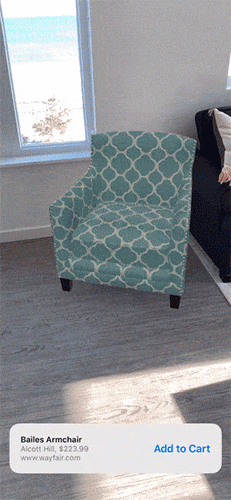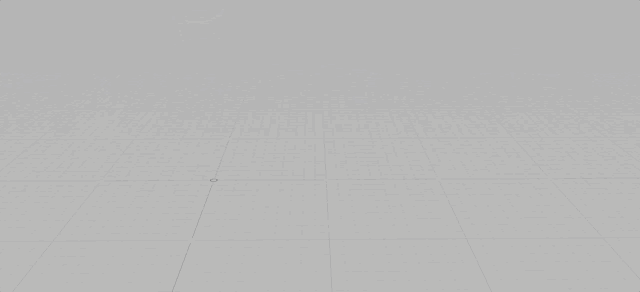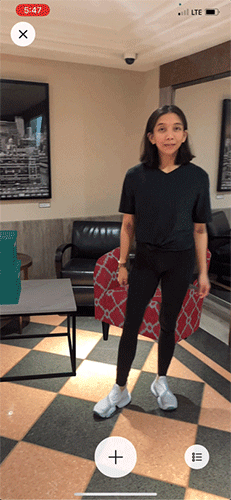Augmented reality (AR) is most well known for its use in mobile games, which encourage users to find virtual objects hidden in the world around them. At Wayfair, we leverage AR beyond pure entertainment to provide value for our shoppers. AR lets shoppers answer important questions like, “Will this item fit in my space?” With AR, virtual 3D versions of products can be seen in a customer’s actual space at true-to-life scale using technology that’s already in their pocket – their smartphone.
The new Wayfair View in Room on iOS 14 with LiDAR bridges enhanced utility and heightened delight when shopping for products for the home.
Wayfair has everything you need for your home across a catalog of more than 18 million items, so shoppers use augmented reality as a decision-making tool to find exactly the right item for them. AR empowers shoppers to determine how a product will fit in their home, both in terms of fitting the physical space and fitting their style, giving them all the information they need to ensure they’re making the right selection.
Building your space
As spatial computing is adopted in factories and remote work, at Wayfair we’re innovating in spatial computing for the home. Earlier this year, the Wayfair iOS App added support for multiple plane types. Scaling beyond just horizontal planes like floors and tables, we launched the ability to view products hanging from the ceilings and attached to vertical planes like walls and doors. Based on customer feedback, we learned that shoppers want a seamless AR experience and the ability to add multiple products in one AR scene.
Leveraging earlier Apple AR experiences
Wayfair has been leveraging Apple’s ARKit to create AR experiences for iOS users since 2017. Earlier this year, we launched View in Room on Safari with AR QuickLook, allowing users to view products in their home and purchase them through AR and Apple Pay. This was also the first Wayfair AR experience with occlusion. By enabling body occlusion, users can stand in front of virtual products as they would appear in the real world.

Enabling higher senses of realism
Continuing to innovate in AR for eCommerce, we integrated RealityKit and LiDAR in the latest version of the Wayfair app, which allows users to place multiple virtual products in their home. Thanks to RealityKit we can enable a higher sense of realism in our View In Room experience, with the addition of better scene understanding and realtime lighting. Realtime lighting allows for virtual products to be properly lit and cast accurate shadows from them based on real world lighting, providing a more authentic view of the product and its material.
With instant plane finding using LiDAR, there are less onboarding users with how to find a surface because it happens with minimal to no effort. While we enabled body occlusion in the app, thanks to the addition of LiDAR we also have environmental occlusion, creating an experience with a higher sense of realism. Environmental occlusion allows products to seamlessly blend into their surroundings, such as having a table fit in between chairs.

| 
|
Following the rules of the real world
As augmented reality experiences should follow the rules of the real world, shoppers can now stack virtual products. When moving a product that has another product on top of it, they move together.

| 
|
Informing decisions and increasing delight
In addition to providing helpful tools and services to shoppers, we also want to foster delightful experiences that keep customers returning to Wayfair time and time again. Our new View in Room is sprinkled with moments of delight from animations to feedback on actions.
While AR experiences should be natural and mimic the real world, we create delight by breaking some rules of the real world by allowing the user to do or see things that are only available with AR. For example, when a product enters the scene, the experience defies physics to rise into view from the surface they are anchored to, such as chairs rising from beneath the floor, or chandeliers growing out of the ceiling.

We also provide feedback on actions with haptics to give a sense of physicality with virtual products. Rather than the muscle strain you feel after assembling a real life sectional in your home, we instead have snappy haptic feedback for completed goals and actions in AR, including adding a product. We also added a delete animation to shrink and spin the product to avoid change blindness and be less jarring than simply disappearing. No more hauling out furniture that doesn’t fit. With View in Room you can have it shrink away with only a tap.

What’s next?
With the latest RealityKit + ARKit additions, we have enabled our shoppers to make better buying decisions in the context of their space. We will expand on this work by adding even more LiDAR features, such as enablement of semantic detection so we can be smarter about where products appear in your space and create a frictionless path towards the products for which a user is shopping. These are experiences we expect to be available on more devices and accessible to more shoppers as AR continues to scale.
Try it
You can experience View in Room on the Wayfair app
here on the Apple App Store on iOS 13 and up.

